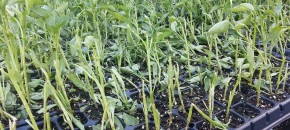With the wet weather, conditions for the crown rot phase of Phytophthora blight have increased. Phytophthora blight typically develops in low-lying areas of fields after a heavy rain and can spread quickly throughout the entire field. Planting on a ridge or raised, dome-shaped bed will help provide better soil drainage.
Continue reading...Severe Hail in Southern New Jersey

On Thursday night areas of southern New Jersey were hit with severe hail. A significant amount of damage was done on all crops across a few of counties (Salem, Gloucester, and Cumberland).
Continue reading...Controlling Emerged Palmer Amaranth in No-Till Burndown
I have observed a lot of emerged Palmer amaranth seedlings. Early planted corn should be scouted at 4 weeks after planting to determine if a POST herbicide application is needed. A lot of no-till soybean fields need a burndown herbicide, and if Palmer amaranth is present in those fields, it makes things challenging. If the […]
Continue reading...Potato Disease Forecasting Report 5-23-14
Potato Disease Forecasting Report 5-23-14 – Click to Download We will be tracking DSVs for Late blight development and calculating P-days for initiating the first early blight fungicide application. The first late blight fungicide application is recommended once 18 DSVs accumulate from green row. Green row typically occurs around the first week in May in southern […]
Continue reading...Tomato Disease Forecasting Report 5-23-14
5-23-14 Tomato Report – Click to Download Disease severity values (DSVs) for early blight, septoria leaf spot, and tomato anthracnose development are determined daily based on leaf wetness (due to rainfall, dew) and air temperature. On a daily basis DSV values can range from 0 to 4 where 0 = no chance for disease development […]
Continue reading...Invasive Emerald Ash Borer Detected in NJ
New Jersey Department of Agriculture today confirmed that the emerald ash borer (EAB), an invasive beetle that attacks and kills ash trees, has been found in Somerset County by a landscaper investigating unhealthy trees in a Bridgewater retail area last week. Inspectors sent insect larvae samples to the USDA where the specimens were confirmed.
Continue reading...